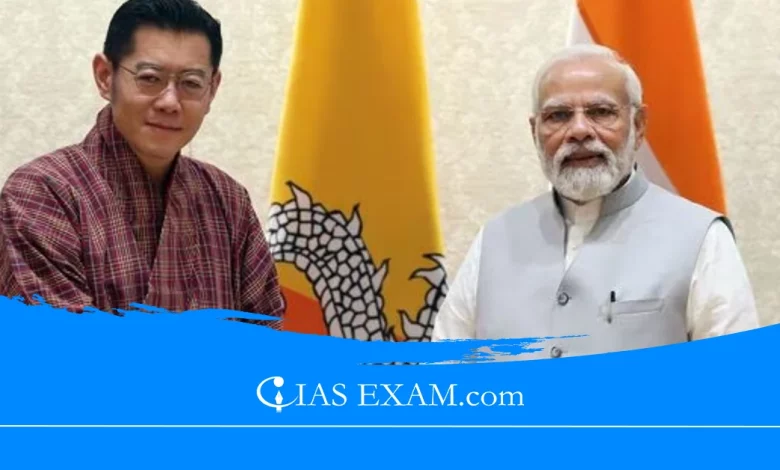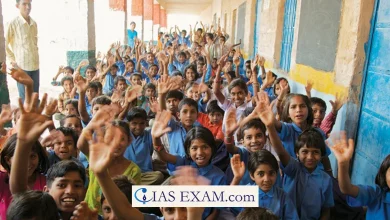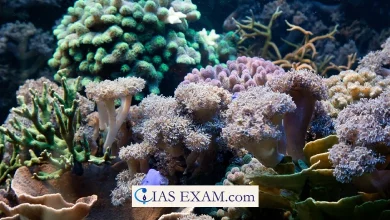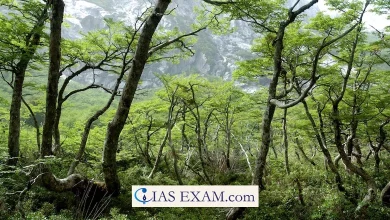Daily Current Affairs for UPSC
MoU between India and Bhutan
Syllabus- International Relations [GS Paper-2]

Context
The Union Cabinet gave its approval for the signing of Memorandum of Understanding (MoU) between the Government of India and the Royal Government of Bhutan.
About
- The MoU signed between the 2 countries is on General Supply of Petroleum, Oil, Lubricants (POL) and related products from India to Bhutan.
- It aims to benefit India and its citizens with stepped forward economic and commercial linkages with Bhutan irrespective of any gender, class or income bias, particularly in the region of hydrocarbon sector.
Expected Benefits of MoU
- The Memorandum of Understanding will promote bilateral trade in the hydrocarbon region and will make certain secured and long time supply of petroleum merchandise to Bhutan.
- Since, exports play an important role in understanding Atma Nirbhar Bharat. The MoU will give thrust closer to self-reliant India.
- The MoU can be a strategic fit as Energy Bridge in India’s Neighborhood First Policy.
India-Bhutan Relations
- Diplomatic relations between India and Bhutan had been established in 1968 with the established order of a special office of India in Thimphu.
- Before this, relations with Bhutan have been sorted by India’s Political Officer in Sikkim.
- The primary framework of India- Bhutan bilateral relation was the Treaty of Friendship and Cooperation signed in 1949 between the 2 countries, which was revised in February 2007.
- The India-Bhutan Friendship Treaty no longer only reflects the modern nature of the relationship however also lays the foundation for their future development in the 21st century.
Major areas of Cooperation
- Hydropower Cooperation
-
-
- Hydropower projects in Bhutan are an instance of win-win cooperation, providing a reliable source of inexpensive and clean energy to India, producing export revenue for Bhutan and cementing our economic integration.
- The ongoing cooperation between India and Bhutan in the Hydropower sector is covered under the 2006 Agreement on Cooperation in Hydropower and the Protocol to the 2006 agreement signed in March, 2009.
- So far, the Government of India has constructed three Hydroelectric Projects (HEPs) in Bhutan totaling 1416 MW (336 MW Chukha HEP, 60 MW Kurichhu HEP and 1020 MW Tala HEP), which might be operational and exporting surplus power to India.
- About three-fourth of the power generated is exported and the rest is used for domestic use.
-
- Bilateral Trade
-
-
- The India-Bhutan Agreement on Trade, Commerce and Transit – which was first signed in 1972 and revised maximum currently for the 5th time in 2016 – establishes a slow change regime between the two countries.
- India is Bhutan’s biggest trading associate. Since 2014, India’s products trade with Bhutan has almost tripled from USD 484 million in 2014-15 to USD 1422 million in 2021-22, accounting for about 80% of Bhutan’s typical trade, with the balance of trade in India’s favour.
- In 2021-22, India’s bilateral trade with Bhutan was USD 1422 million, of which India’s exports to Bhutan amounted to USD 877 million and India’s imports from Bhutan were USD 545 million.
-
- Border Management
-
-
- There is a Secretary-level mechanism on border control and protection associated subjects. There is also a Border District Coordination Meeting Mechanism between the bordering States and the Royal Government of Bhutan to facilitate coordination on border control and other related matters.
-
- Water Resource Management
-
-
- There is a Joint Group of Experts (JGE) on flood management between India and Bhutan to discuss/ examine the possible reasons and effects of the recurring floods and erosion in the southern foothills of Bhutan and adjoining plains in India and to advise suitable measures to both Governments.
-
- Educational and Cultural Cooperation
-
-
- A large range of university going Bhutanese college students are studying in India. It is anticipated that approximately 4000 Bhutanese are studying in Under Graduate programmes in Indian Universities on a self-financing basis.
-
- ITEC Training Programme Scheme
-
- Every year GoI gives 300 education slots under ITEC programme and a further 60 slots under TCS Colombo Plan in various fields to Bhutanese for upgrading their administrative and technical competencies.
Challenges
- China’s Growing Influence: China’s growing presence near the disputed India-Bhutan-China border and its developing economic ties with Bhutan boost worries for India’s strategic interests.
- Delay in Projects: Delays and disagreements regarding sales sharing from India-Bhutan hydropower projects can create anxiety.
- Trade Dependence: Bhutan’s heavy reliance on India for trade makes it liable to economic fluctuations in India.
- Hydropower Projects and Environmental Risks: Bhutan has issues about environmental and social influences from hydropower projects.
- Motor Vehicle Agreement: India’s plans for a Motor Vehicle Agreement in the Bangladesh-Bhutan-India-Nepal grouping have faced delays.
- Power Purchasing Policy: India’s sudden change in its power buying policy, rigid rates, and refusal to allow Bhutan to enroll in the national energy grid and trade with third countries like Bangladesh has strained relations.
Measures Needed
- Strengthening Economic Cooperation: India can put money into infrastructure improvement, tourism, and different sectors to diversify Bhutan’s economic system and decrease its dependence.
- Enhanced Connectivity: Improved road, rail, and air links will increase trade, tourism, and people-to-people exchanges.
- Cultural and Educational exchanges: Programs fostering cultural understanding and educational opportunities can strengthen the bond between the two countries.
- Strategic Dialogue: Regular high-stage talks on safety and border problems can deal with issues and maintain transparency.
- Addressing Bhutan’s Concerns: India ought to deal with Bhutan’s anxieties regarding China’s effect through sensitive diplomacy and economic cooperation.
- Multilateral Cooperation: Collaboration on nearby projects like hydropower and infrastructure improvement may be pursued by agencies like BIMSTEC (Bay of Bengal Initiative for Multi-Sectoral Technical Cooperation).
Way Forward
- Maintaining a strong and collectively beneficial relationship with Bhutan is vital for India’s strategic interests in the region.
- By addressing challenges and enforcing the measures required, India and Bhutan can ensure a rich and stable future for each country.
Source: The PIB
UPSC Mains Practice Question
Q.What are the challenges in the India Bhutan relationship? Enumerate strategies that have been proposed to address these challenges. (250 words)





.png)



